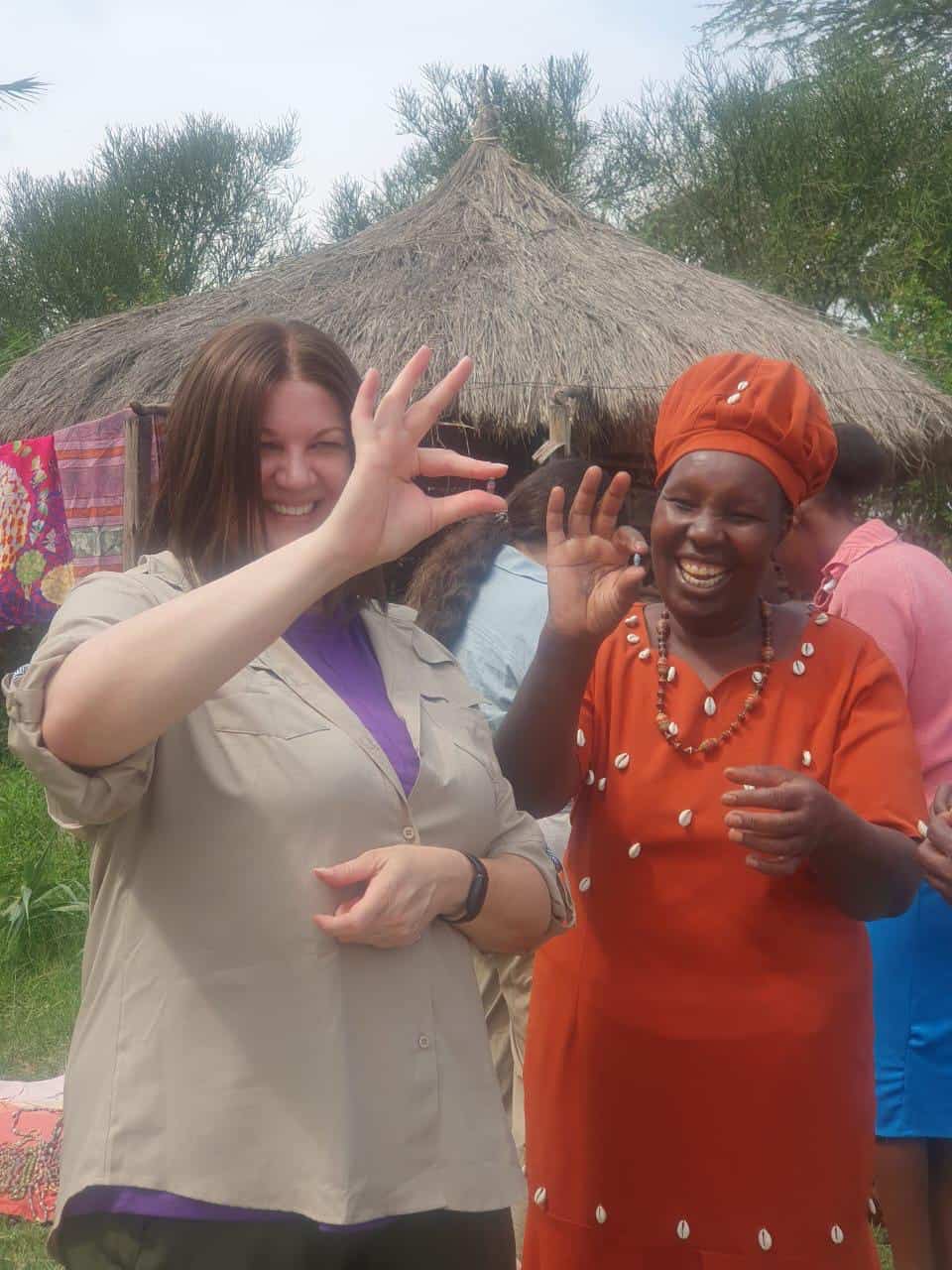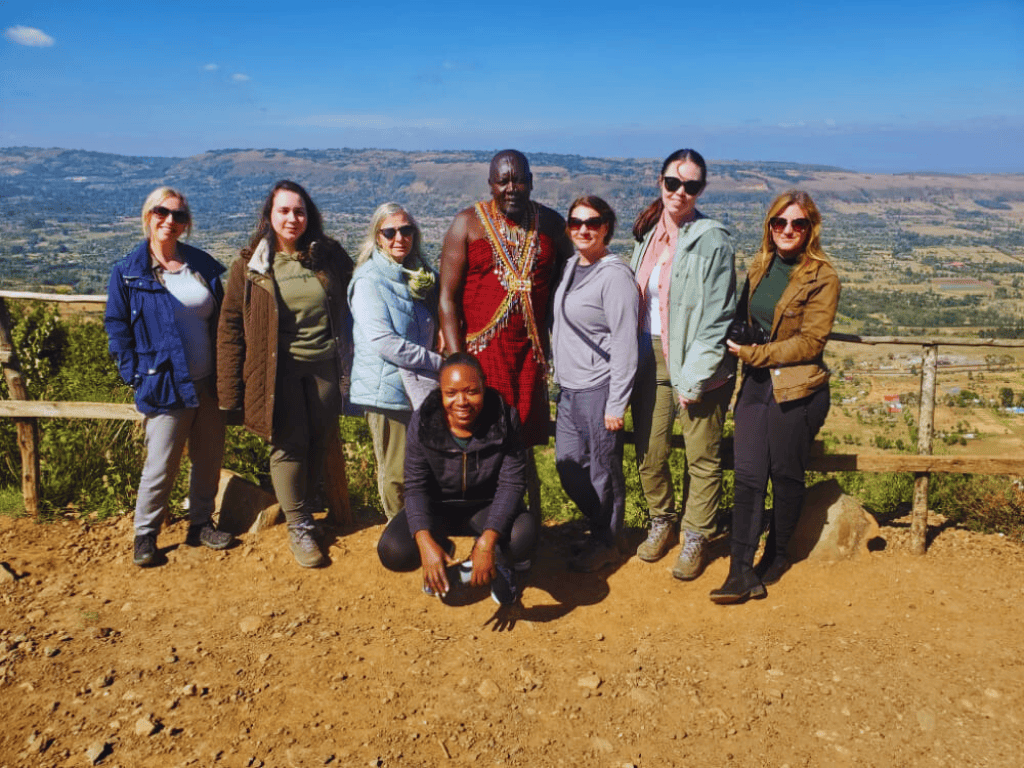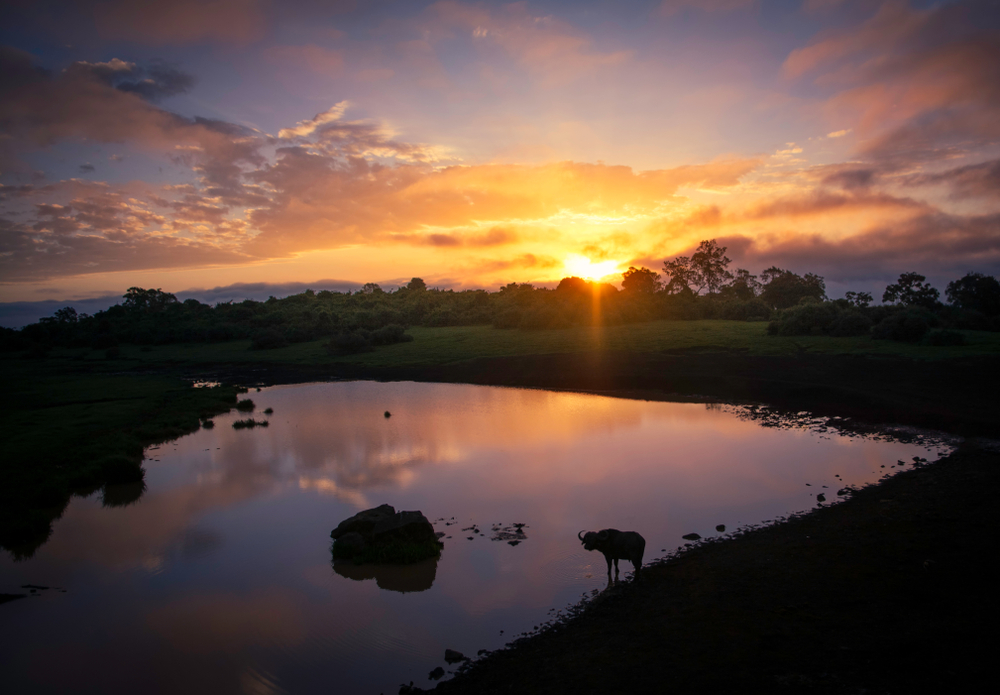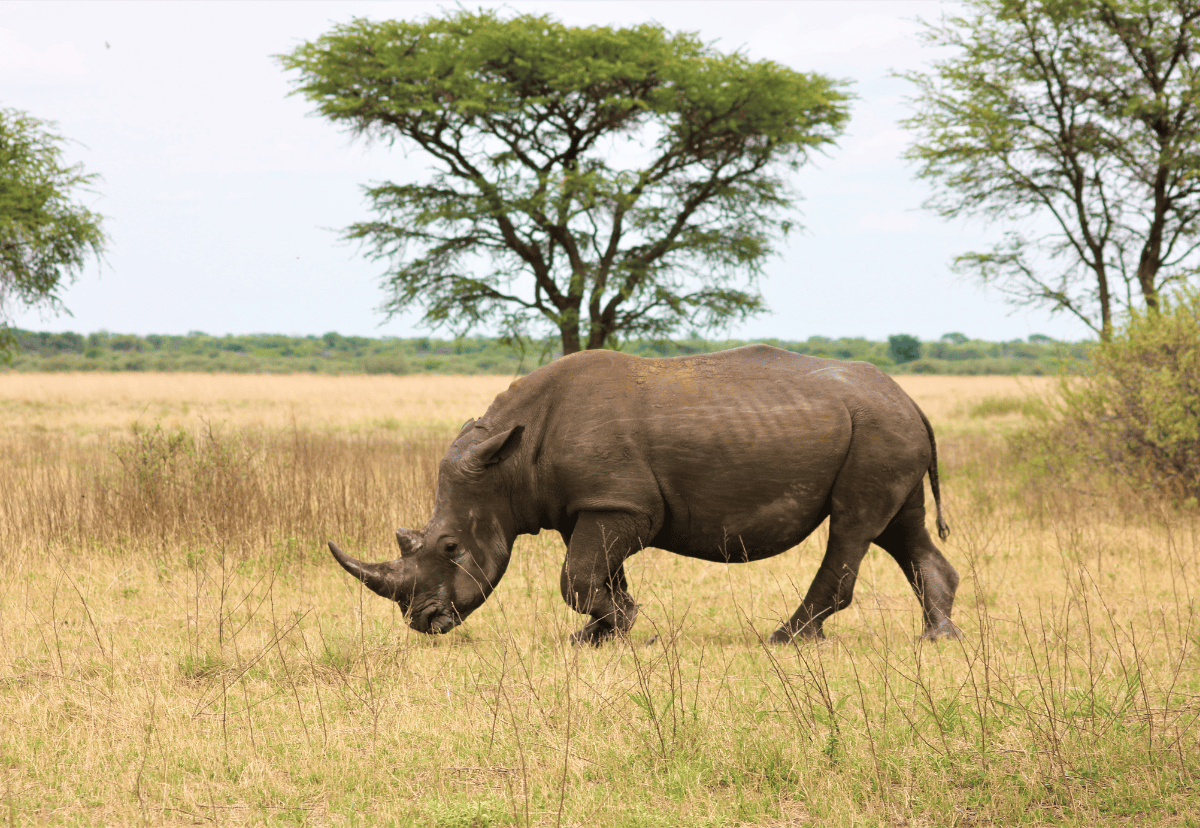From adventurous morning game drives to vibrant Nairobi night markets to afternoon tea and finger sandwiches – here’s how to pack smart, stay comfy, and respect the culture in Kenya.
Kenya is one of those rare places that sweeps you up in its rhythm. You’ll sip tea on a veranda while giraffes roam in the distance, spot leopards at dawn, and sit with women in a remote village who are rewriting the future for their daughters. But if you’re wondering what to pack for a trip like that—where you’re moving between national parks, cultural villages, and forested lodges—it’s not as simple as tossing some sundresses in a bag.
With hot days, chilly nights, and a mix of terrain (from the Aberdare highlands to the Masai Mara savanna), you’ll want to pack with versatility in mind. Add to that the cultural respect required in rural areas, the bumpy safari roads, and the solo safety considerations! Whether you’re prepping for a high-altitude nature walk, relaxing at a lodge overlooking a watering hole, or joining a market visit in Mount Kenya region, this guide will help you pack with confidence.
(And if you want the stress-free version of travel, check out our Kenya Meetup Tour. We’ll handle the logistics—you just show up with your backpack and your curiosity.)
Table of Contents
Why Packing Right for kenya Matters For Solo Female Travelers
Kenya isn’t just one landscape—it’s a journey through several. One day, you’re winding through the misty forests of the Aberdare Mountains; the next, you’re crossing golden savannas in the Masai Mara or sharing tea in a village few travelers ever reach. It might sound overwhelming, but don’t worry—you don’t need more, you just need smart. Layering is key, comfort is non-negotiable, and modesty is a sign of cultural respect.
🦓 Game drives: You’ll spend hours in open-roof safari vehicles—dust, sun, and early morning chills are all part of the experience.
🧺 Village visits & markets: It’s important to dress respectfully in these more conservative, rural areas.
🌿 Forest lodges & highlands: Nights can be cold, even in the dry season. A cozy layer will make your stay much more enjoyable.
“I thought I packed light, but I still brought stuff I never used! I wish I had known that I’d basically be living in the same 4 outfits. The best thing I packed? A scarf—it worked as a cover-up, a blanket on the safari truck, and a pillow on long drives!”
— Jasmine, The Kenya Tour 2023
Clothing: What to Wear in kenya as a Solo Female Traveler
Packing for Kenya is all about versatility. You need breathable fabrics for the heat, modest options for cultural respect, and lightweight layers for cool safari mornings. Here’s exactly what to pack for each part of your trip:
For Safari (Masai Mara, Aberdare, Lake Nakuru)
Kenya’s national parks can get hot, dusty, and surprisingly cold in the mornings. You’ll spend hours in a safari jeep, so comfort is key.
✅ Neutral colors (khaki, olive, taupe)—they don’t attract insects and blend in better.
✅ Lightweight, long-sleeved tops—sun protection + keeps bugs off.
✅ Breathable long pants—comfort for game drives and bush walks.
✅ Fleece or warm jacket—mornings are cold, especially at higher altitudes.
✅ Sports bra—those game drive roads are bumpy.
🚫 Skip: Bright colors, jeans (too hot/dusty), and white clothes (turn brown in 0.2 seconds).
for Villages, local markets, cultural sights
When visiting local communities, dressing respectfully isn’t just polite—it’s a meaningful way to show appreciation and build genuine connection. A few thoughtful clothing choices can go a long way.
✅ Maxi skirts or loose pants—cool, modest, and respectful.
✅ Tunic tops or T-shirts—shoulder coverage matters in rural Kenya.
✅ Lightweight scarf—easy way to add coverage on the go.
🚫 Skip: Spaghetti straps, short shorts, and plunge tops or crop tops.

Shoes & Footwear: What to Wear on Your Feet in kenya
If you’re the kind of traveler who thinks, “I’ll just bring my favorite sneakers and call it a day,” think again. Kenya’s terrain changes fast, and your feet will thank you for planning ahead.
For Safari & Hiking
You’ll be on your feet more than you think—between game drives, lodge walkways, and cultural visits.
✅ Hiking boots or sturdy trekking shoes – If you’re planning any walking safaris, hikes, or visiting Mount Kenya, you’ll want ankle support and solid grip.
✅ Closed-toe sneakers – Even if you’re not hiking, safaris can be dusty, and sneakers will keep your feet cleaner than sandals.
✅ Thick hiking socks – Helps prevent blisters & keeps feet warm on early morning game drives.
🚫 What NOT to bring: Heavy-duty mountaineering boots (unless you’re actually climbing Mount Kenya—otherwise, they’re overkill).
villages, local markets, Cultural Visits
✅ Comfortable walking shoes – Streets can be uneven, so opt for comfy sneakers, walking shoes, or closed-toe sandals.
✅ Something dressier (if you plan to go out) – A simple pair of nice sandals works for restaurants and rooftop bars.
🚫 What NOT to bring: Anything you wouldn’t want ruined by dust or rain.
“I almost didn’t bring hiking boots because I thought I wouldn’t need them. BIG mistake. Walking to the safari lodges and just moving around in the dirt roads? My sneakers were toast. Wish I had better shoes for that.”
— Rachel, The South Africa Tour 2018
Eco-Friendly Bath Products
Since some campsites and lodges have limited plumbing, it’s important to use biodegradable products to avoid harming the environment.
✅ Solid shampoo & conditioner bars – Last longer, no leaks, better for the planet.
✅ Biodegradable soap & body wash – Keeps you clean while protecting the local water systems.
✅ Menstrual cup or organic pads/tampons – If you use disposables, bring enough for the trip since they may not be available in remote areas.
🚫 What NOT to bring: Anything with strong artificial fragrances (bugs love scented products).
Skincare & Sun Protection
The sun in Kenya is no joke even when it’s colder—expect high UV exposure even on cloudy days.
✅ High-SPF sunscreen
✅ Aloe vera gel
✅ Lip balm with SPF
🚫 What NOT to bring: Glass bottles (they break easily in transit).
General Hygiene Must-Haves
✅ Hand sanitizer & wet wipes – Some places don’t have soap or running water.
✅ Travel toilet paper – Public bathrooms may not have toilet paper (or even an actual toilet).
✅ Deodorant wipes – Sometimes a full shower isn’t possible, and these keep you fresh on the go.
Health & Safety Essentials: What Every Solo Female Traveler Needs
You don’t need to pack an entire pharmacy, but a little preparation goes a long way when you’re traveling solo in Kenya.
Medications & Vaccines
Before you go, check Kenya’s vaccine requirements. Some essentials include:
✅ Malaria prevention – Kenya is a malaria zone. DEET-based repellents + prescribed malaria tablets are a must.
✅ Yellow fever vaccine – Required if you’re coming from a country with yellow fever.
✅ Traveler’s diarrhea meds – You don’t want to be caught off guard.
First Aid Kit (Don’t Skip This!)
✅ Pain relievers (for headaches from long travel days).
✅ Electrolyte tablets (for dehydration from heat or food adjustments).
✅ Antiseptic wipes & band-aids (blisters & scrapes happen).
✅ Eye drops (dust from safaris can irritate your eyes).
🚫 What NOT to bring: A huge first aid kit (you don’t need a full pharmacy, just essentials).
Solo Female Safety Gear
Kenya is generally safe for solo female travelers, but a few small items can give extra peace of mind:
✅ Personal safety alarm – Small, loud, and great for emergency situations.
✅ Door stop – If you’re staying in a budget hotel or guesthouse, this adds an extra layer of security.
✅ Safety whistle – Good for attracting attention if needed.

Electronics & Travel Gadgets: What You Actually Need
You don’t need to bring every gadget you own, but a few smart electronics will make your trip smoother—especially when you’re dealing with limited WiFi, long safari drives, and unpredictable power sources.
Power & Charging Essentials
✅ Universal travel adapter – Kenya uses Type G (UK-style) so for most, a universal adapter is a must.
✅ Power bank – Some safari lodges and campsites don’t have power 24/7, so a strong portable charger will save you when your phone dies mid-photo.
✅ Headlamp or flashlight – Crucial for camping (some lodges have limited lighting at night) and useful for power outages in cities.
🚫 What NOT to bring: A hairdryer (most eco-lodges don’t allow them), high-voltage styling tools (voltage differences can fry them).
Photography & Travel Tech
✅ Smartphone with a good camera – You don’t need a bulky DSLR unless you’re a professional—modern phone cameras capture wildlife surprisingly well.
✅ Binoculars – Many travelers regret not bringing these—game drives are even better when you can see details up close.
✅ Extra SD card & storage – You’ll take more photos than you think, so have backup storage!
🚫 What NOT to bring: A drone (Kenya has strict regulations, and many parks don’t allow them).

Documents & Money: What to Prepare Before Your Solo Trip To Kenya
The last thing you want is to arrive in Kenya and realize you forgot something crucial—like your visa paperwork, proof of insurance, or enough cash for tipping. Here’s what to get in order before you go:
Must-Have Travel Documents
✅ Passport (with at least 6 months validity) – Double-check your expiration date! Kenya won’t let you in if your passport is too close to expiring.
✅ Electronic Travel Authorization (eTA) – As of January 2024, Kenya has removed its traditional visa requirement for all nationalities. It’s now replaced with an eTA, which is faster, simpler, and costs around $30 USD.
→ Apply at the official site: www.etakenya.go.ke
→ Processing time: Typically 3 business days, but apply at least 1–2 weeks in advance just in case.
→ You’ll need: A scanned copy of your passport, passport-style photo, proof of onward travel, and proof of accommodation.
✅ Printed travel insurance details – WiFi isn’t always reliable, so keep a physical copy of your insurance policy just in case.
✅ Copies of important documents – Keep digital & hard copies of your passport, visa, and emergency contacts in case of loss or theft.
🚫 What NOT to do: Wait until the last minute. Most airlines will ask for proof of your eTA before boarding, and you won’t be allowed to enter Kenya without it.
Money: How to Pay for Things in Kenya
Cash is still king across much of Kenya, especially in rural areas and national parks. Some lodges and larger establishments accept cards, but you’ll want cash handy for tips, local markets, and small purchases.
✅ Kenyan Shillings (KES) – The local currency is widely used everywhere outside of major hotels and airports.
✅ Small USD bills – Some tourist services and tipping guides still prefer or accept USD. Bills should be crisp and issued after 2006.
✅ Small bills for tipping – Keep $1, $5, and $10 bills for guides, porters, and lodge staff.
✅ ATM access – ATMs are available in Nairobi and larger towns, but can be scarce near national parks—withdraw enough before heading into safari regions.
✅ Credit card with no foreign transaction fees – Good for hotel payments, some shops, and emergencies. Visa cards are more widely accepted than Mastercard.
🚫 What NOT to do: Assume you’ll always find an ATM—remote lodges and parks may be hours away from the nearest bank.

Safari-Specific Gear: What Makes the Experience More Comfortable
Safaris are incredible, but they come with long days, bumpy rides, and unpredictable weather. A few small items can make a huge difference in your comfort and experience.
What to Pack for Game Drives
✅ A lightweight daypack – Keep essentials (camera, water bottle, sunscreen) within reach during game drives.
✅ Sunglasses & hat – The sun is harsh, and the glare from the savanna can be blinding.
✅ Buff or scarf – Useful for blocking dust on bumpy roads and keeping warm on chilly mornings.
✅ Refillable water bottle – Stay hydrated, especially on full-day game drives where stops are limited.
✅ Packable rain jacket – Even in the dry season, unexpected showers happen.
What Makes Camping in the Bush Easier
✅ Earplugs – Nature is loud at night (think crickets, baboons, and distant lions), so if you’re a light sleeper, you’ll want these.
✅ Sleep sheet or lightweight sleeping bag – Some camps provide bedding, but it’s nice to have your own layer for extra comfort.
✅ Portable travel fan – If you’re sensitive to heat, a small USB-powered fan makes a big difference inside safari tents.
🚫 What NOT to bring: Too much luggage—most safari vehicles have weight limits, so pack light!

Final Packing Tips & Common Mistakes to Avoid as a solo female traveler in Kenya
Even experienced travelers make some classic packing mistakes in Kenya. Here’s how to avoid them:
Common Overpacking Regrets
🚫 Too many clothes – Most travelers rotate the same 4–5 outfits, so less is more.
🚫 Bulky luggage – Soft duffel bags are better than hard-shell suitcases for fitting into safari jeeps.
🚫 Bringing jeans – They’re too hot, take forever to dry, and get stiff with dust.
Things You’ll Be Glad You Packed
✅ A headlamp – Game lodges get dark fast, and you’ll want hands-free lighting.
✅ A quick-dry towel – Essential for beach days and when lodges don’t provide towels.
✅ A good book or offline entertainment – Safari drives can be long between wildlife sightings.
✅ A scarf – to protect yourself from dust, to use as an extra layer when it’s cold, or to cover your shoulders when in rural, conservative areas.
Conclusion: What To Pack As A Solo Female Traveler In kenya
Kenya is one of the most unforgettable destinations for solo female travelers, and packing smart means traveling with confidence. When it comes to packing for Kenya, focus on layers, comfort, and versatility. Bring neutral-colored, breathable clothing for safari days, a warm jacket for chilly mornings in the highlands, and modest outfits like loose pants and tunics for village visits.
You’ll want sturdy walking shoes for safaris and forest walks, and comfortable sandals for relaxing at lodges. Pack eco-friendly toiletries, high-SPF sunscreen, mosquito repellent, and a small first aid kit for peace of mind.
Don’t forget your eTA paperwork, plenty of cash in small bills, a universal adapter, a power bank, and binoculars if you want a closer look at the incredible wildlife.
The key? Pack light, pack smart, and leave extra room for the memories you’ll make
And if you want a stress-free way to experience it all, check out our Kenya Adventure Tour—we’ve already handled the logistics, so all you have to do is pack and go!
FAQ: What Solo Female Travelers Ask About Packing for kenya
1. Do I need hiking boots, or will sneakers be okay?
If you’re doing any hiking or walking safaris, hiking boots are best. If not, sneakers are fine for everyday wear, but we strongly recommend at the least trail running/walking or hiking shoes.
2. Can I bring a rolling suitcase?
Duffel bags are better for safari jeeps, but rolling suitcases work if you’re mainly in cities & hotels.
3. Is it safe for solo female travelers to wear shorts in Kenya?
Shorts are okay on safari, but in cities and rural areas, loose pants or skirts are better for cultural respect.
4. Do I need to bring mosquito repellent?
Yes! Kenya is a malaria-risk area, so bring DEET-based repellent or a natural alternative.
5. Will I need a rain jacket, even in the dry season?
Yes. Sudden rain showers can happen. A lightweight, packable rain jacket is ideal.
6. Can I wear tank tops in Kenya?
In safari lodges and hotels, yes. But in cities and villages, it’s better to cover shoulders with a light scarf or T-shirt.
7. What’s the best type of bag to bring for safari?
A soft duffel bag is best for fitting into safari vehicles, and a small daypack is handy for game drives.
8. How much cash should I carry in Kenya?
ATMs are available in cities but not reliable in remote areas. Bring a mix of USD and Kenyan Shillings (KES) for tipping and small purchases.
9. Is laundry available on safari or in lodges?
Many lodges offer laundry service, but it’s a good idea to bring a few quick-dry clothing items and travel detergent if you want to handwash something yourself.
10. Will I need a power adapter in Kenya?
Most likely, yes. Kenya uses Type G plugs (similar to UK). A universal travel adapter will cover you.





